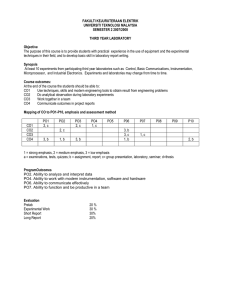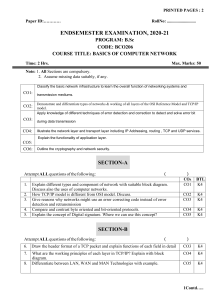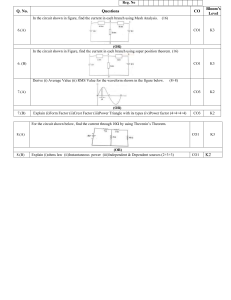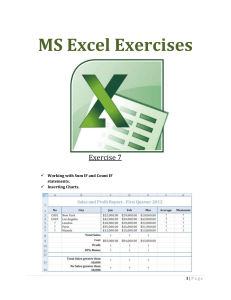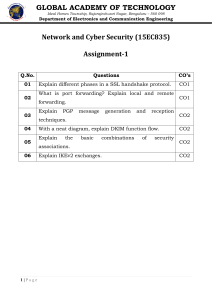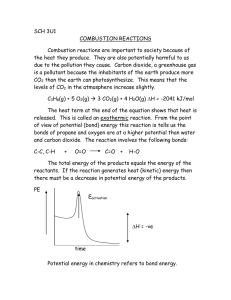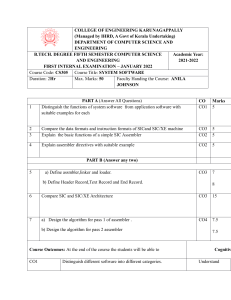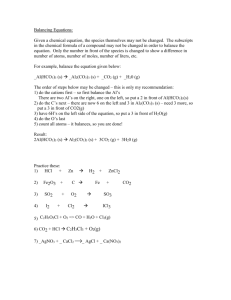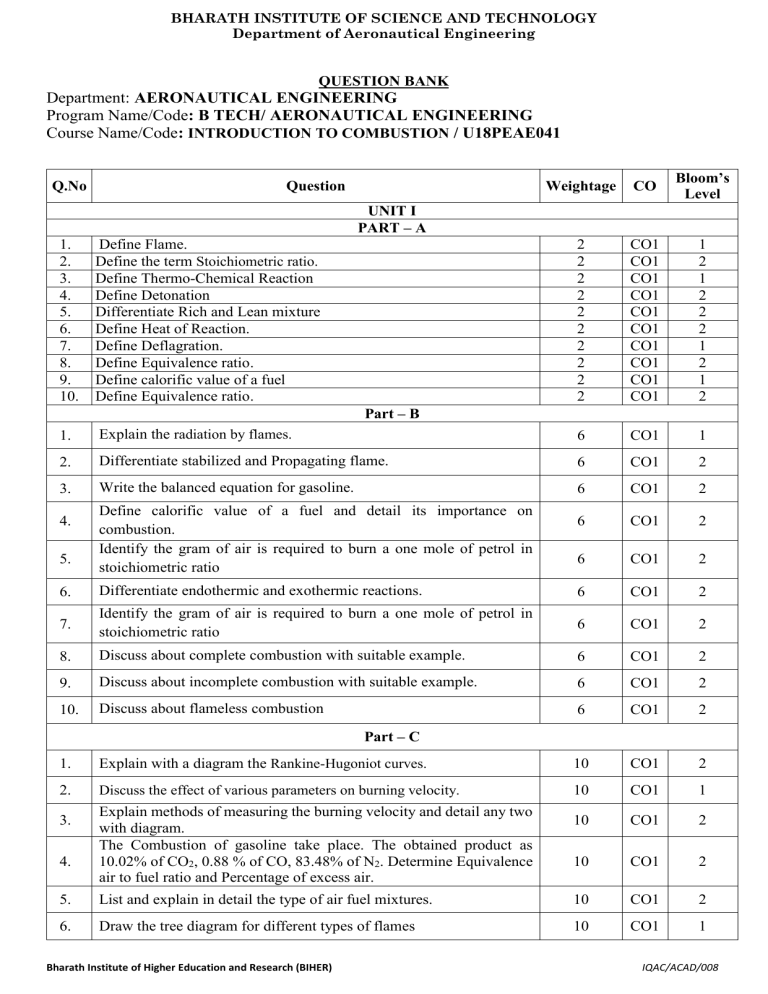
BHARATH INSTITUTE OF SCIENCE AND TECHNOLOGY Department of Aeronautical Engineering QUESTION BANK Department: AERONAUTICAL ENGINEERING Program Name/Code: B TECH/ AERONAUTICAL ENGINEERING Course Name/Code: INTRODUCTION TO COMBUSTION / U18PEAE041 Q.No Question Weightage CO Bloom’s Level 2 2 2 2 2 2 2 2 2 2 CO1 CO1 CO1 CO1 CO1 CO1 CO1 CO1 CO1 CO1 1 2 1 2 2 2 1 2 1 2 UNIT I PART – A 1. 2. 3. 4. 5. 6. 7. 8. 9. 10. Define Flame. Define the term Stoichiometric ratio. Define Thermo-Chemical Reaction Define Detonation Differentiate Rich and Lean mixture Define Heat of Reaction. Define Deflagration. Define Equivalence ratio. Define calorific value of a fuel Define Equivalence ratio. Part – B 1. Explain the radiation by flames. 6 CO1 1 2. Differentiate stabilized and Propagating flame. 6 CO1 2 3. Write the balanced equation for gasoline. 6 CO1 2 6 CO1 2 6 CO1 2 4. 5. Define calorific value of a fuel and detail its importance on combustion. Identify the gram of air is required to burn a one mole of petrol in stoichiometric ratio 6. Differentiate endothermic and exothermic reactions. 6 CO1 2 7. Identify the gram of air is required to burn a one mole of petrol in stoichiometric ratio 6 CO1 2 8. Discuss about complete combustion with suitable example. 6 CO1 2 9. Discuss about incomplete combustion with suitable example. 6 CO1 2 10. Discuss about flameless combustion 6 CO1 2 Part – C 1. Explain with a diagram the Rankine-Hugoniot curves. 10 CO1 2 2. Discuss the effect of various parameters on burning velocity. 10 CO1 1 10 CO1 2 10 CO1 2 3. 4. Explain methods of measuring the burning velocity and detail any two with diagram. The Combustion of gasoline take place. The obtained product as 10.02% of CO2, 0.88 % of CO, 83.48% of N2. Determine Equivalence air to fuel ratio and Percentage of excess air. 5. List and explain in detail the type of air fuel mixtures. 10 CO1 2 6. Draw the tree diagram for different types of flames 10 CO1 1 Bharath Institute of Higher Education and Research (BIHER) IQAC/ACAD/008 BHARATH INSTITUTE OF SCIENCE AND TECHNOLOGY Department of Aeronautical Engineering 7. Discuss in detail about the application of Thermo-Chemical reaction. Bharath Institute of Higher Education and Research (BIHER) 10 CO1 2 IQAC/ACAD/008 BHARATH INSTITUTE OF SCIENCE AND TECHNOLOGY Department of Aeronautical Engineering Q.No Question Weightage CO Bloom’s Level UNIT II PART – A 1. 2. 3. 4. 5. 6. 7. 8. 9. 10. Name the working cycle of an IC engine. Define Reaction rate. Define octane rating. Define compression ratio. Define volatility. Differentiate TDC and BDC. Define cetane number. Define preignition Define efficiency of an engine. Define detonation. 2 2 2 2 2 2 2 2 2 2 CO2 CO2 CO2 CO2 CO2 CO2 CO2 CO2 CO2 CO2 1 2 1 1 1 2 1 1 1 1 1. Part – B Discuss the classification of piston engines. 6 CO2 1 2. Differentiate CI and SI Engines. 6 CO2 2 3. Define turbulence and how it affects the performance of the IC engine. 6 CO2 1 4. Explain abnormal combustion and list two control methods 6 CO2 2 5. Explain why spark plug is not installed in a diesel engine 6 CO2 2 6. Discuss about homogenous combustion with suitable example. 6 CO2 2 7. Discuss about heterogenous combustion with suitable example. 6 CO2 2 8. Explain the concept of crankcase dilution. 6 CO2 2 9. Discuss about the fuel used in aviation sector. 6 CO2 2 10. Explain about the reaction rate and transposition rate. 6 CO2 2 Part – C 1. Explain in detail the various factors affecting the combustion efficiency in a Piston engine. 10 CO2 2 2. Define detonation and explain the factors affecting the detonation. 10 CO2 1 3. List the criteria for selecting the fuel in a piston engine. 10 CO2 2 4. Explain with a neat sketch the combustion process in SI engine. 10 CO2 2 5. Explain with a neat sketch the construction and working of an IC engine 10 CO2 2 6. Explain with a neat sketch the combustion process in CI engine. 10 CO2 2 7. Discuss the various methods to prevent detonation. 10 CO2 2 Bharath Institute of Higher Education and Research (BIHER) IQAC/ACAD/008 BHARATH INSTITUTE OF SCIENCE AND TECHNOLOGY Department of Aeronautical Engineering Q.No Question Weightage CO Bloom’s Level 1. 2. 3. 4. 5. 6. 7. 8. 9. 10. 2 2 2 2 2 2 2 2 2 2 CO3 CO3 CO3 CO3 CO3 CO3 CO3 CO3 CO3 CO3 1 2 1 1 2 1 2 1 2 1 1. UNIT III PART – A Define air-fuel ratio and give the value for Gas turbine engine. Differentiate Air-fuel and stoichiometric ratio Define combustion intensity. Define stoichiometric ratio and give the value for Gas turbine engine. Differentiate gas turbine and ramjet engines. Define stagnation condition. Define Dilution in combustion. Define rapid combustion. List four performance parameter in a combustion process. Define recirculation. Part – B Describe the characteristics of the fuel used in Gas turbine engine. 6 CO3 2 2. Discuss how recirculating flow pattern is achieved. 6 CO3 2 3. Define turbulence and how it affects the performance of the Gas turbine engine. 6 CO3 1 4. Discuss the factors influencing design of the Gas turbine combustor. 6 CO3 2 5. Discuss the losses in the GT combustors. 6 CO3 2 6. Explain the concept of Coking. 6 CO3 1 7. List the types of flame holders and describe any two. 6 CO3 2 8. Explain the importance of combustion intensity. 6 CO3 1 9. Explain in detail about the purpose of swirler in a GT engine. 6 CO3 1 10. Discuss the concept of stability loop. 6 CO3 1 Part – C 1. Explain the combustion process of a Gas Turbine Engine with a sketch. 10 CO3 2 2. Explain the various type of combustor of GT engine with a diagram. 10 CO3 2 3. Explain the combustion process of a ramjet engine with sketch. 10 CO3 2 4. Explain the process and importance of flame stabilization. 10 CO3 2 5. Explain the factors affecting the combustion efficiency of GT engine. Explain the factors affecting the combustion efficiency of ramjet engine Explain in detail about the pollutants in combustion process. 10 CO3 2 10 CO3 2 10 CO3 2 6. 7. Bharath Institute of Higher Education and Research (BIHER) IQAC/ACAD/008 BHARATH INSTITUTE OF SCIENCE AND TECHNOLOGY Department of Aeronautical Engineering Weightage CO Bloom’s Level 2 2 2 2 2 2 2 2 2 2 CO4 CO4 CO4 CO4 CO4 CO4 CO4 CO4 CO4 CO4 1 1 1 1 1 1 1 1 1 1 1. Define Convection. Define detonation. Define shock wave. List the types of shock waves formed in a scramjet engine. Define stagnation condition. Differentiate supersonic and subsonic flame holders. List few applications where scramjet is used. List the components of scramjet engine. Define airbreathing engine List the need for hypersonic combustion. Part – B Explain the types of flow with reference to Mach number. 6 CO4 2 2. Explain the components of scramjet engine with a neat sketch. 6 CO4 2 3. Explain subsonic combustion. 6 CO4 2 4. Discuss the factors that affects the supersonic combustion. 6 CO4 2 5. Describe the process of supersonic combustion. 6 CO4 1 6. Discuss about the concept of external combustion 6 CO4 2 7. Explain about the purpose of isolator in scramjet engine 6 CO4 2 8. Discuss about the concept of mixed combustion 6 CO4 2 9. Explain about the nozzle used in scramjet engine. 6 CO4 2 10. Discuss about the concept of internal combustion 6 CO4 2 10 CO4 2 10 CO4 2 Q.No Question UNIT IV PART – A 1. 2. 3. 4. 5. 6. 7. 8. 9. 10. Part – C 2. Explain the combustion process of a scramjet engine with a neat sketch. List and discuss the types of compression in a scramjet engine. 3. Discuss the nozzle construction of a scramjet engine. 10 CO4 2 4. List and discuss the types of mixing in a scramjet engine. 10 CO4 2 5. Discuss the factors affecting the efficiency of the scramjet engine. Explain with the neat sketch construction and working of a scramjet engine. Explain in detail about the air-fuel mixing in scramjet engine. 10 CO4 1 10 CO4 2 10 CO4 2 1. 6. 7. Bharath Institute of Higher Education and Research (BIHER) IQAC/ACAD/008 BHARATH INSTITUTE OF SCIENCE AND TECHNOLOGY Department of Aeronautical Engineering Q.No Question Weightage CO Bloom’s Level 2 2 2 2 2 2 2 2 2 2 CO5 CO5 CO5 CO5 CO5 CO5 CO5 CO5 CO5 CO5 1 1 2 1 1 1 2 1 1 1 6 CO5 2 UNIT IV PART – A 1. 2. 3. 4. 5. 6. 7. 8. 9. 10. 1. Define non airbreathing engine Define specific impulse. Write the thrust equation of a rocket propulsion. List the parameters of the performance of rocket propulsion. Define oxidizer. Define Internal energy Define total impulse. Define thrust coefficient. Define the law that governs rocket propulsion. Define characteristic velocity Part – B Describe the primary propulsion and auxiliary propulsion. 2. Describe the types of fuel in rocket propulsion and give examples for each. 6 CO5 2 3. Explain the electro thermal rocket propulsion with a sketch. 6 CO5 2 4. Differentiate the pump fed and pressure fed system in rocket propulsion. 6 CO5 2 5. Explain the working of isolation valve. 6 CO5 2 6. Discuss the concept of auxiliary propulsion with a sketch. 6 CO5 2 7. Discuss the need for thermal insulation in a rocket system 6 CO5 2 8. Explain the three stages of an ignition system. 6 CO5 2 9. Explain the role of a binder and discuss any two in detail. 6 CO5 2 10. Explain the parameters affecting the thrust. 6 CO5 2 Part – C 1. 2. Explain in detail with a sketch about ionic propulsion system Explain the mono-propellant propulsion system with neat sketch. 10 10 CO5 CO5 2 2 3. 10 CO5 2 10 CO5 2 5. Explain the working of rocket propulsion system with neat sketch. Explain the factors affecting performance parameters of the rocket propulsion. Explain the bi-propellant propulsion system with neat sketch. 10 CO5 2 6. Explain in detail about the hybrid rocket system. 10 CO5 2 7. Explain in detail with a sketch about electric propulsion system 10 CO5 2 4. Bharath Institute of Higher Education and Research (BIHER) IQAC/ACAD/008
